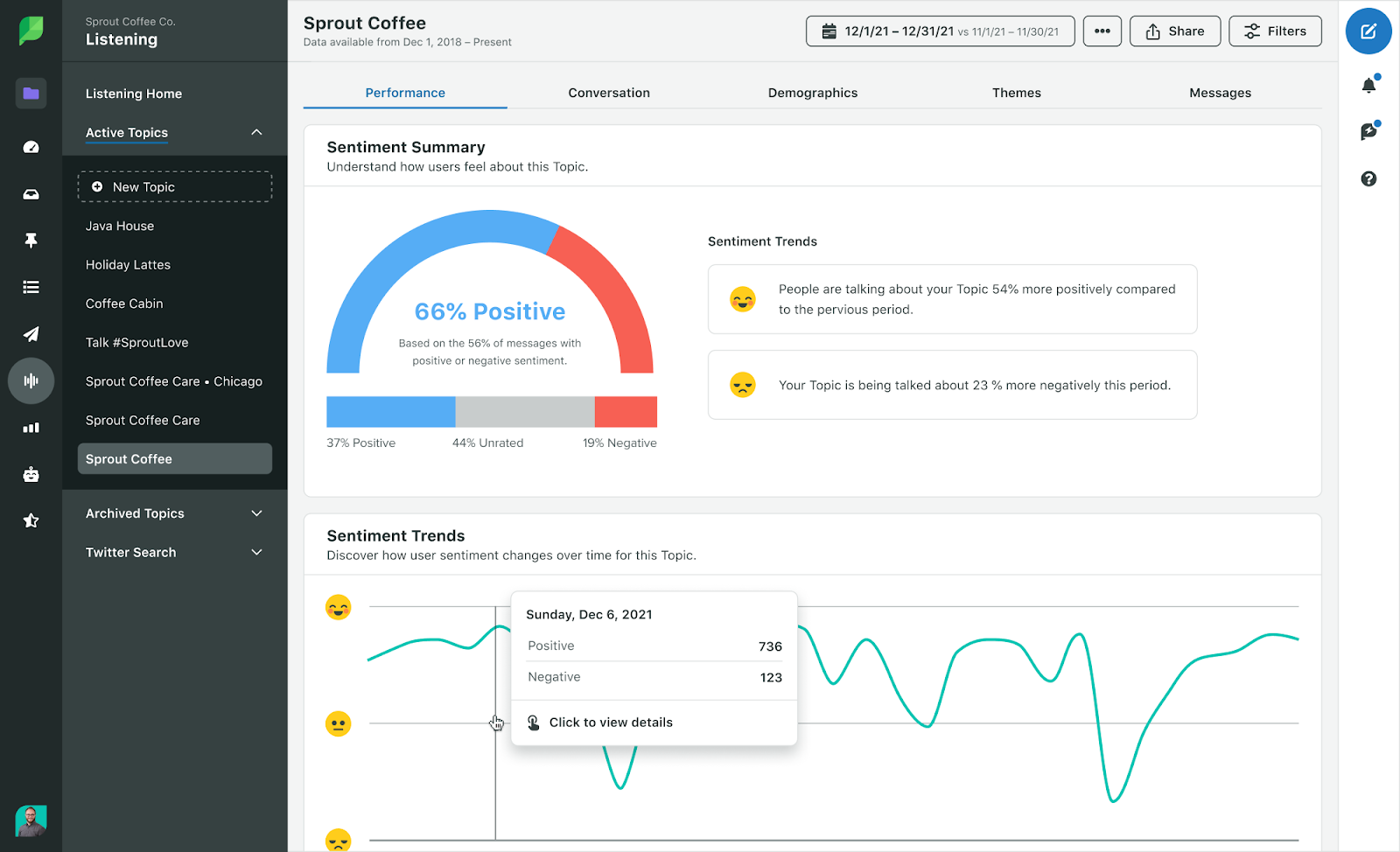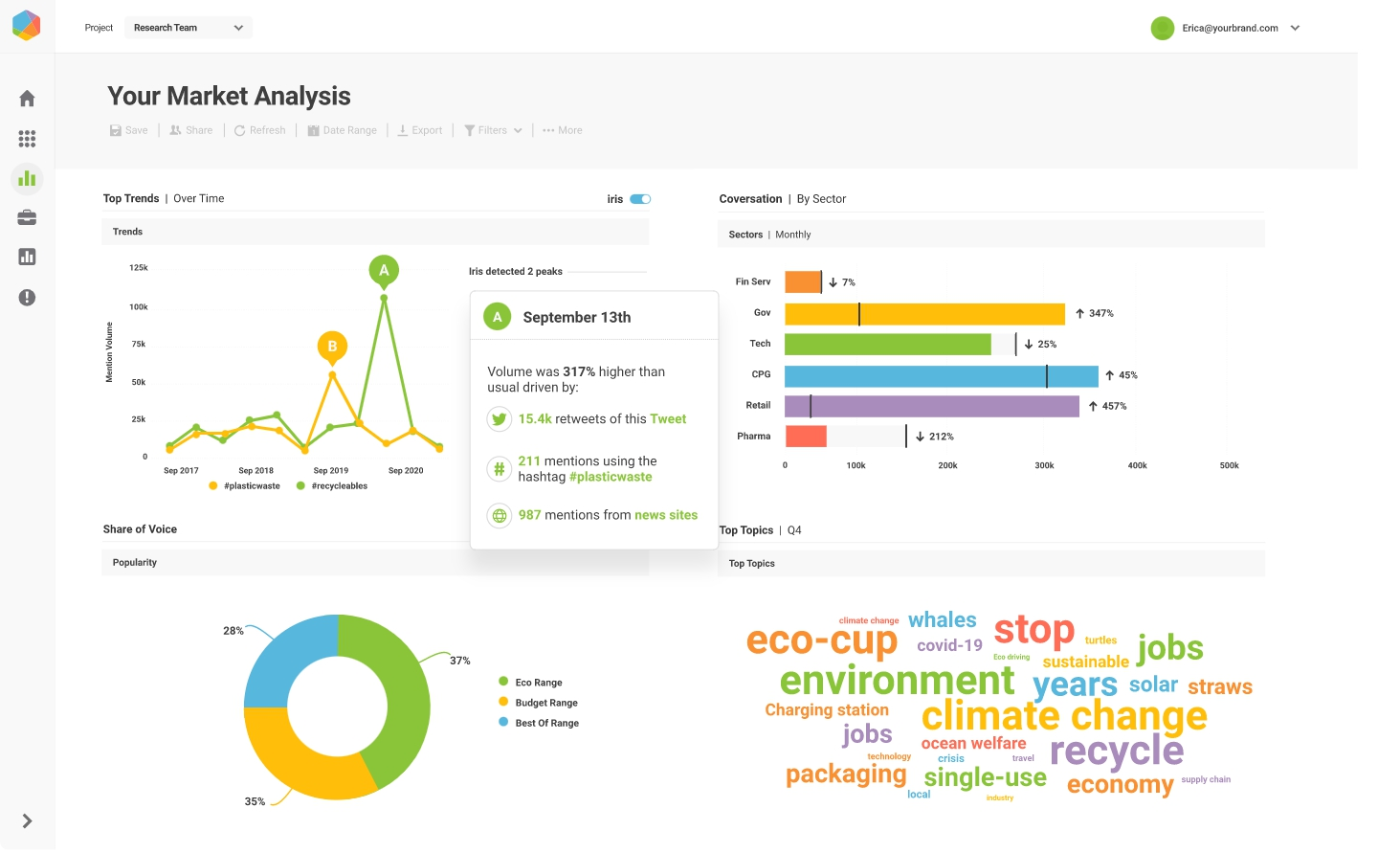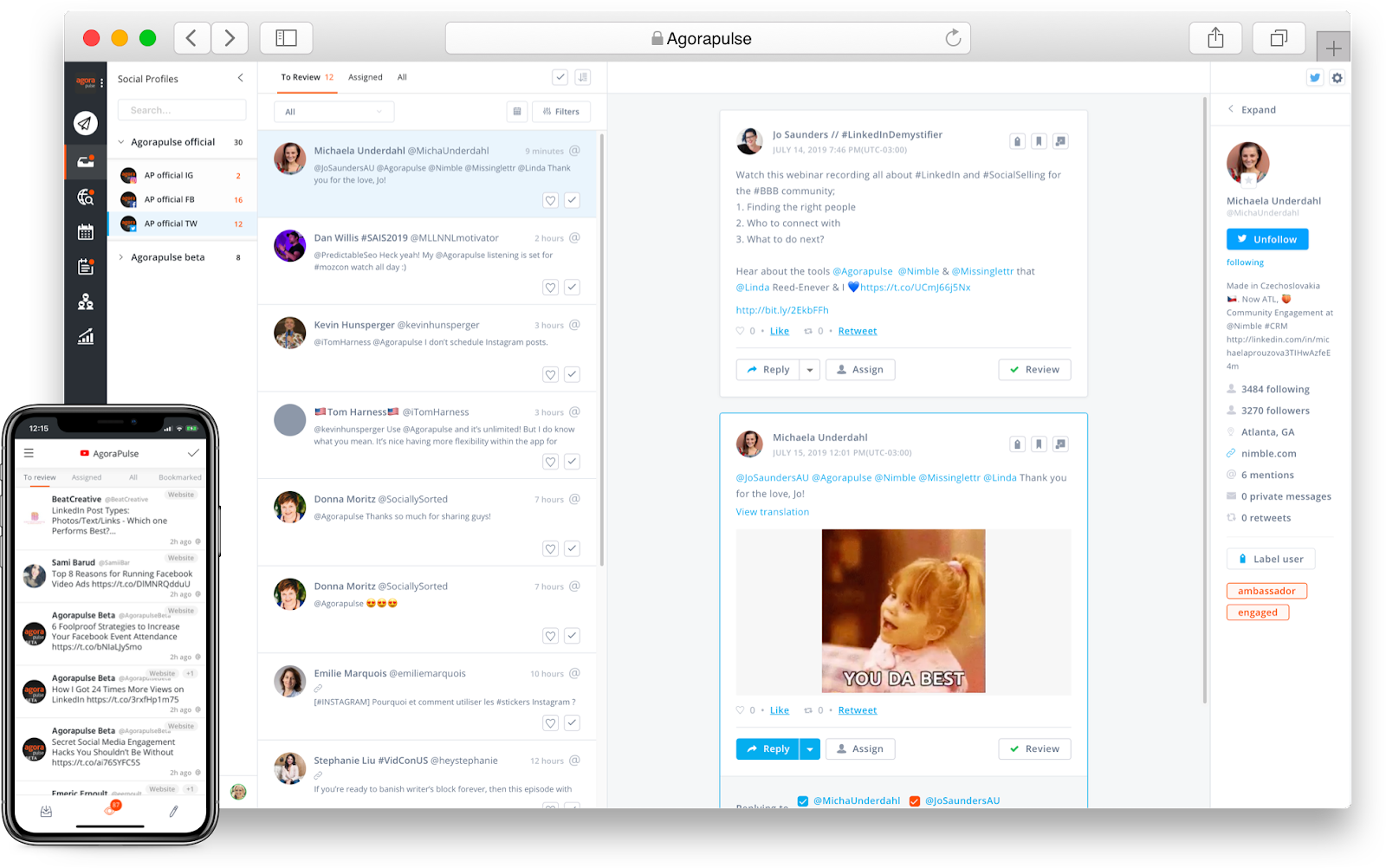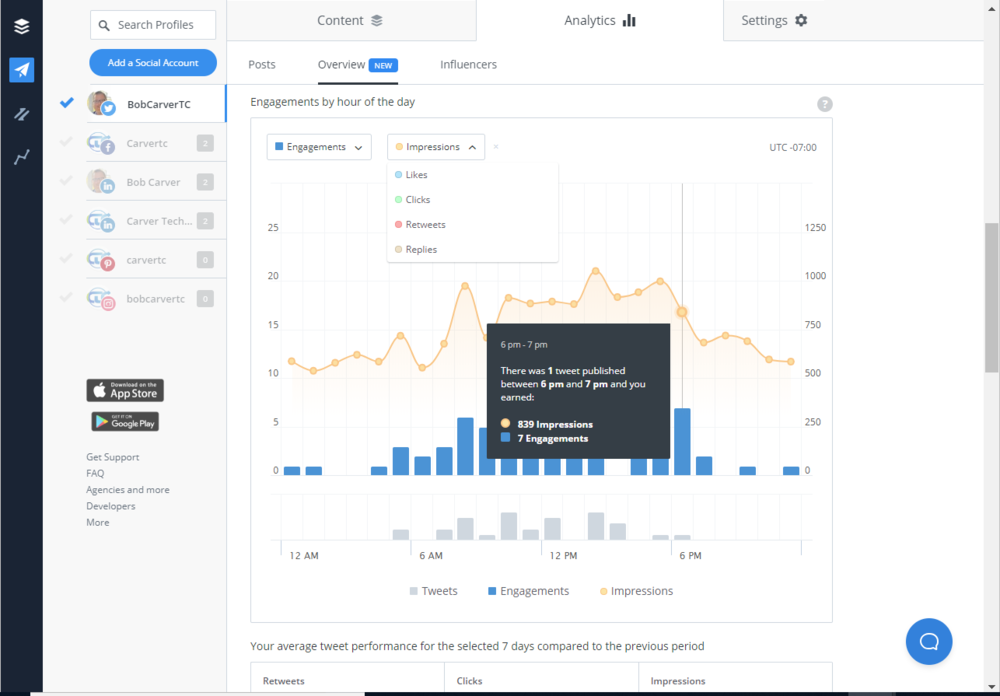Social media listening is the process of keeping tabs on how your customers and leads feel about your product, brand, and competitors. It requires monitoring and analyzing brand mentions, competitor mentions, hashtags, trends, discussions, and reviews to unlock valuable insights and act on them.
In this article, you'll get to know why social media listening matters and how it differs from social monitoring and learn how to make the most out of social listening tools.
Why is social media listening important?
Think about your favorite coffee shop or bakery. What makes it special? Maybe the staff knows your name, favorite drink, how much sugar you add to your coffee, or your preferences and allergies, offering a dessert you're likely to enjoy. Or perhaps they are just not indifferent to your opinion on all these things. One way or another, they care and do their best to provide excellent customer service.
Social media listening allows you to do just that without missing any info you could use to your advantage. Analyzing how users feel about your brand provides the following benefits.
- Reacting quickly. Special tools like Sprout Social or Hootsuite enable marketers to track their brand mentions on socials. This enables you to interact with users quickly, provide customer support, and react to their complaints and negative feedback timely.
- Revealing customers' unmet needs. Monitoring keywords and hashtags related to your industry allows you to find clients' pain points that you have not tended to yet. Keep track of your customers' social media sentiment to discover how they feel about your brand. If the sentiment is down, you can get to know the reasons and take action immediately.
- Forecasting hard times for your brand. Luckily, you can predict a crisis before it overtakes your company by keeping tabs on sentiments. So, if you find out about negative reviews and feelings regarding your brand early, you'll be able to prevent a catastrophe for your company.
- Analyzing competitors. Knowing how people feel about your competitors is just as crucial as understanding what they think about your company. Analyzing their campaigns, product releases, and social media strategy will help you uncover their strengths and weaknesses and use the obtained data in your strategy.
- Discovering prospects. When monitoring your brand and product mentions on socials, you'll uncover a segment of potential clients who are interested in your services but still have some doubts. These leads may ask questions about your brand to collect feedback from your existing customers. The great news is that you can detect these prospects, provide them with personalized help, send a demo, make a relevant offer, etc. This is your chance to turn more leads into clients.
- Identifying brand advocates. While analyzing all the discussions, mentions, and hashtags connected to your brand, you may encounter frequent buyers and people who adore your brand. Satisfied customers are generous with praise. Once you find them, show that you appreciate them, make special offers, and offer collaboration.
As you see, social media listening provides businesses with tons of pros. Before you implement this strategy, you need to start with social media monitoring. Let's make the difference between these two approaches clear.
Social Media Listening vs. Social Media Monitoring
These terms are closely related to each other and are implemented together. Still, there are some differences between them.
Social media monitoring is the first step toward understanding your customers. It requires monitoring your brand and competitor mentions, hashtags, and trends to have a clear picture of how your brand is presented on social media. Tracking ROI and creating A/B testing campaigns are the two primary goals of social media monitoring. Marketers using this approach are generally interested in customers' engagement with their brand.
Social media listening implies looking beyond the engagement metrics and brand mentions. With the help of this strategy, you can find answers to questions like "Why are customers feeling this way about our product?" This feeling is called social media sentiment. Tracking it is essential for social media listening. Brands use the collected data to enhance their marketing campaigns, customer service, and brand development.
So, both approaches are crucial for maintaining healthy relationships with your audience. Now you might be interested in how to get started with this process, so let's get into it.
How do you get started with social media listening?
Since social media monitoring is prior to social listening, it is your starting point. To analyze any data, you need to collect it first.
To make the process less challenging and time-consuming, consider using social media listening tools. While choosing one, make a list of social media platforms where you want to gather data. They can include Facebook, Instagram, Twitter, YouTube, TikTok, etc. The more channels you choose, the more accurate your results are. Next, find a tool that can collect data across all the social media platforms you choose. This way, you'll save money and time since each service requires some time to understand how it works.
To set the ball rolling, you need to create a list of keywords relevant to your business. They should include the following:
- your brand name;
- product name;
- company hashtag;
- industry-related hashtags;
- campaign-specific hashtags;
- CEO, spokesperson, and top manager names;
- your slogan;
- industry keywords;
- common misspellings of everything mentioned above.
After you add keywords to your tool, the process is launched. You'll get to know the sentiment around your brand, mentions, comments, reviews, frequently asked questions, discussions, and other insights that you can use to your benefit.
Explore your brand mentions on social media. The majority of your mentions will reflect people's feelings about your brand on social media. If there are a lot of negative mentions, figure out what the issue is (e.g., product quality, customer service, marketing campaigns, etc.) and take action to resolve it.
Find out what people admire about your brand. This data will be your blueprint for improvement. You'll be able to enhance your benefits and invest in things customers love about your company.
Reveal your clients' pain points. Firstly, focus on your company's customers. Monitor the issues they face daily and react immediately. Then, single out the pain points of your competitors' clients to be able to offer help at the right time. Consider assigning a person responsible for tracking these customers on socials. This way, you'll solve customers' problems quickly and show that your brand cares about them.
Identify your clients' frequently asked questions. They will help you understand what common issues they face and fail to find answers on your social media profile or website. Create a list of FAQs and let your chatbot answer them to free up your customer support team's time. With SendPulse, you can create a Facebook Messenger, Instagram, WhatsApp, and Telegram chatbot for free.
Now that you know how to get started with social media listening, let's look at the five most popular tools.
Top 5 Social Media Listening Tools
In this section, we'll introduce you to the best social media listening tools that will help you obtain priceless insights into your brand performance.
Sprout Social
Sprout Social is a powerful platform for building and managing your relationships with customers on social media. With this service, you can organize your tasks and ensure a smooth workflow when working with your social media accounts. You can create, publish, and schedule content, get in-depth reports, and keep track of analytics.
The user-friendly social listening tool enables you to get a deeper understanding of your customers' needs. You can monitor all the info about your brand, industry, and competitors mentioned on social media and analyze your brand health and customer sentiment. The service enables you to find your brand advocates and opinion leaders and connect with them.
If you are thinking about launching a new product, you can collect user feedback and ideas to create something really valuable. With Sprout Social, you can explore different industry gaps and evaluate your opportunities to increase market share.
Below you can see a customer dashboard on Sprout Social where you can find different sentiment trends.

Hootsuite
Hootsuite is a platform for social media monitoring and social listening. It allows you to manage your profiles on several social networks from one place. Hootsuite offers features that help with engaging your customers, scheduling posts and messages, collaborating with your team, delegating messages to the right team members, monitoring what clients say about your company and competitors, and viewing analytics.
With the help of your dashboard, you can quickly respond to customers' messages on several social media and create a list of your leads, important clients, and influencers you want to contact. The Hootsuite Insights feature allows you to explore and analyze your customer sentiment. ReviewTrackers is a Hootsuite app that allows you to track your brand reviews on more than 50 sites and share them on social media.
Check out the Hootsuite dashboard below. You can see several columns in the Steams section — your social media feed connected to Hootsuite.

Brandwatch
Brandwatch is a social media analytics tool that allows you to keep tabs on your brand mentions on social networks, blogs, forums, and news to get a clear picture of how customers see your brand, understand what trends to follow, and find influencers to collaborate with. The platform provides smart AI to get deep consumer insights from 100 million sources.
With Brandwatch, you can analyze your brand health and monitor brand mentions and real-time changes in customer sentiment. The platform enables you to analyze your industry trends even if your brand is not mentioned and improve your brand messaging based on unstable consumer perceptions.
Brandwatch warns you about impending crises using real-time alerts. This way, you won't miss any disastrous brand mentions and be able to act immediately. You can share helpful reports, insight screens, and email updates with any team member to keep them in the know.
Below you can see an example of market analysis you can get in your BrandWatch account.

Agorapulse
Agorapulse is a social media management platform that helps you keep track of all your messages on socials, publish and schedule content, find key opinion leaders, and stay organized with your analytics across all channels.
Agorapulse enables you to monitor all of your conversations and messages from one place, identify your fans, categorize users to give your team some context before contacting them, and keep an eye on your Facebook and Instagram comments. You can make use of saved replies, inbox filters, and one-click translations to prevent chaos in your inbox.
Agorapulse provides intuitive publishing features for you to ensure smooth collaboration with your team, including a big-picture content overview. You can create personalized content, reschedule posts, and publish everything on the go.
You can label any important conversation or competitor activity to have quick access to it. Monitor your customers' feedback and respond immediately.
Below you can see comments and messages received in the Agorapulse inbox. You can label and translate them or respond using saved replies.

Buffer
Buffer is a social media marketing tool that allows clients to measure their performance on social media. Its core functionality includes Buffer Publishing for post-scheduling, Buffer Analytics for actionable reports, and Buffer Engagement for social media listening.
With Buffer, you can schedule posts, tailor and customize them for specific networks, plan and prepare your Stories, respond to comments immediately, and track your progress. You can highlight users' important comments using your dashboard, see unanswered comments, and receive alerts once your sentiment becomes negative. You can discover Stories and post analytics, get insights into audience demographics and boosted posts, monitor each network's most important engagement metrics, get daily updates on your reports, and receive custom reports.
Below you can see Buffer's post engagement analytics. You can see the time when your audience interacts with your posts the most.

Congrats, now you know why social media listening is crucial to your business and have learned about the top five tools that will help you improve your brand performance on socials.
Last Updated: 22.03.2023

or